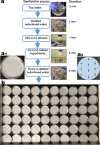Influence of various temperatures, seed priming treatments and durations on germination and growth of the medicinal plant Aspilia africana
- PMID: 35986064
- PMCID: PMC9391371
- DOI: 10.1038/s41598-022-18236-2
Influence of various temperatures, seed priming treatments and durations on germination and growth of the medicinal plant Aspilia africana
Abstract
For millennia, Aspilia africana has been used across Africa to treat various diseases including malaria, wounds, and diabetes. In this study, temperature influenced the in vitro germination of A. africana with highest final germination percentage (FGP) and germination index (GI) of 65.0 ± 7.64% and 2.26 ± 0.223, respectively, at 19.8 °C. Priming seeds with H2O, KNO3, and GA3 (gibberellic acid 3) improved both in vitro germination and ex vitro emergence of A. africana seeds. Seed priming with [Formula: see text] M GA3 produced overall highest in vitro FGP (from 90.0 ± 4.08% to 100 ± 0.00%) and GI (from 2.97 ± 0.385 to 3.80 ± 0.239) across all priming durations. Seeds primed with KNO3 had better germination parameters for 6 and 12 h compared to 18 and 24 h. Furthermore, the highest in vitro FGP (100 ± 0.00%) was observed in seeds primed for 12 h with [Formula: see text] M GA3. Ex vitro A. africana seed emergence was significantly enhanced by GA3 priming. Priming A. africana seeds with H2O, KNO3, and GA3 improved their growth after 3 months, with the overall best growth for seeds primed with [Formula: see text] M GA3. Seed priming of A. africana is a feasible approach for improving germination and seed emergence, and enhancing plant growth.
© 2022. The Author(s).
Conflict of interest statement
The authors declare no competing interests.
Figures





References
-
- Ajeigbe K, Onifade A, Omotoso D, Enitan S, Olaleye S. Anti-ulcerogenic activity of Aspilia africana leaf extract: Roles of gastric acid, oxidative stress and neutrophil infiltration. Afr. J. Biomed. Res. 2014;17:193–201.
Publication types
MeSH terms
LinkOut - more resources
Full Text Sources

